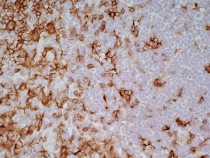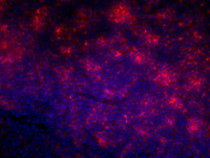ARG22571
anti-CD4 antibody [OX-38]
anti-CD4 antibody [OX-38] for Flow cytometry,IHC-Frozen sections,Immunoprecipitation and Rat
Developmental Biology antibody; Immune System antibody; Regulatory T cells Study antibody; T-cell infiltration Study antibody; Tumor-infiltrating Lymphocyte Study antibody
Overview
| Product Description | Mouse Monoclonal antibody [OX-38] recognizes CD4 This antibody recognizes the rat CD4 cell surface antigen, also known as W3/25 antigen or T-cell surface antigen T4/Leu-3. CD4 is a 430 amino acid ~55 kDa single pass type I transmembrane glycoprotein expressed by T helper cells, monocytes and macrophages.Clone OX-38 competes for binding with Mouse anti Rat CD4 antibody, clone W3/25. Mouse anti Rat CD4 (Domain 1) antibody, clone OX-38 has been utilized successfully for the in vitro depletion of T helper cells from slice cultures in studies looking at myelin loss in multiple sclerosis, the observed disruption being abrogated in these experimental conditions by T-cell depletion (Pusic et al. 2015). |
|---|---|
| Tested Reactivity | Rat |
| Tested Application | FACS, IHC-Fr, IP |
| Host | Mouse |
| Clonality | Monoclonal |
| Clone | OX-38 |
| Isotype | IgG2a |
| Target Name | CD4 |
| Antigen Species | Rat |
| Immunogen | MLR generated rat T cells. |
| Conjugation | Un-conjugated |
| Alternate Names | CD4mut; CD antigen CD4; T-cell surface glycoprotein CD4; T-cell surface antigen T4/Leu-3 |
Application Instructions
| Application Suggestion |
|
||||||||
|---|---|---|---|---|---|---|---|---|---|
| Application Note | * The dilutions indicate recommended starting dilutions and the optimal dilutions or concentrations should be determined by the scientist. |
Properties
| Form | Liquid |
|---|---|
| Purification | Purification with Protein G. |
| Buffer | PBS and 0.09% Sodium azide |
| Preservative | 0.09% Sodium azide |
| Concentration | 1 mg/ml |
| Storage Instruction | For continuous use, store undiluted antibody at 2-8°C for up to a week. For long-term storage, aliquot and store at -20°C or below. Storage in frost free freezers is not recommended. Avoid repeated freeze/thaw cycles. Suggest spin the vial prior to opening. The antibody solution should be gently mixed before use. |
| Note | For laboratory research only, not for drug, diagnostic or other use. |
Bioinformation
| Database Links | |
|---|---|
| Gene Symbol | Cd4 |
| Gene Full Name | Cd4 molecule |
| Background | CD4 is a membrane glycoprotein of T lymphocytes that interacts with major histocompatibility complex class II antigenes and is also a receptor for the human immunodeficiency virus. This gene is expressed not only in T lymphocytes, but also in B cells, macrophages, and granulocytes. It is also expressed in specific regions of the brain. The protein functions to initiate or augment the early phase of T-cell activation, and may function as an important mediator of indirect neuronal damage in infectious and immune-mediated diseases of the central nervous system. Multiple alternatively spliced transcript variants encoding different isoforms have been identified in this gene. [provided by RefSeq, Aug 2010] |
| Function | CD4 is an integral membrane glycoprotein that plays an essential role in the immune response and serves multiple functions in responses against both external and internal offenses. In T-cells, functions primarily as a coreceptor for MHC class II molecule:peptide complex. The antigens presented by class II peptides are derived from extracellular proteins while class I peptides are derived from cytosolic proteins. Interacts simultaneously with the T-cell receptor (TCR) and the MHC class II presented by antigen presenting cells (APCs). In turn, recruits the Src kinase LCK to the vicinity of the TCR-CD3 complex. LCK then initiates different intracellular signaling pathways by phosphorylating various substrates ultimately leading to lymphokine production, motility, adhesion and activation of T-helper cells. In other cells such as macrophages or NK cells, plays a role in differentiation/activation, cytokine expression and cell migration in a TCR/LCK-independent pathway. Participates in the development of T-helper cells in the thymus and triggers the differentiation of monocytes into functional mature macrophages. [UniProt] |
| Highlight | Related products: CD4 antibodies; CD4 ELISA Kits; CD4 Duos / Panels; Anti-Mouse IgG secondary antibodies; Related news: New antibody panels and duos for Tumor immune microenvironment Tumor-Infiltrating Lymphocytes (TILs) |
| Research Area | Developmental Biology antibody; Immune System antibody; Regulatory T cells Study antibody; T-cell infiltration Study antibody; Tumor-infiltrating Lymphocyte Study antibody |
| Calculated MW | 51 kDa |
| PTM | Palmitoylation and association with LCK contribute to the enrichment of CD4 in lipid rafts. |
Images (4) Click the Picture to Zoom In
-
ARG22571 anti-CD4 antibody [OX-38] IHC-Fr image
Immunohistochemistry: Rat lymph node cryosection stained with ARG22571 anti-CD4 antibody [OX-38]. (Low power).
-
ARG22571 anti-CD4 antibody [OX-38] IHC-Fr image
Immunohistochemistry: Rat lymph node cryosection stained with ARG22571 anti-CD4 antibody [OX-38]. (Medium power).
-
ARG22571 anti-CD4 antibody [OX-38] IHC-Fr image
Immunohistochemistry: Rat lymph node cryosection stained with ARG22571 anti-CD4 antibody [OX-38]. (High power).
-
ARG22571 anti-CD4 antibody [OX-38] IHC-Fr image
Immunohistochemistry: Rat lymph node cryosection stained with ARG22571 anti-CD4 antibody [OX-38]. Nuclei are counterstained blue with DAPI.









